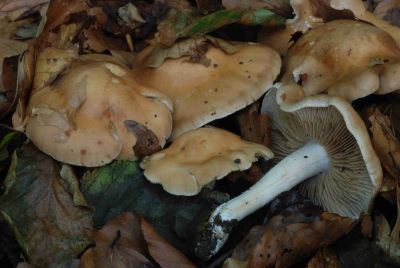Hebeloma is a genus of fungi that forms part of the wood wide webAlthough the wood wide web is named in analogy to the world wide web of computers, it has existed for 500 million years longer than its digital cousin. : They are ectomycorrhizal mushrooms, so they are symbiotic with various trees and shrubs; their hyphae interact with the roots of these plants and exchange nutrients and water. They form part of the underground network which exists throughout most of the world’s woodlands and forests. Indeed, in many of the world's woodlands, and in particular in arctic and alpine environments where willows are present, Hebeloma are an important and common group of fungi. They are also commonly found in boreal and temperate woodlands and more rarely in tropical woodlands.
This website is devoted to Hebeloma, commonly known as 'poison pies'. To date, we have studied more than 10,000 collections of Hebeloma from all over the world, almost 6,000 of which are from Europe and over 3,000 are from North America. Our study involves both morphological and molecular analysis, combined with habitat and locality data. While the habitat and locality data is only as good as the collectors observations, an analysis of the data does provide some biogeographical information for each species. In this first release of the website we provide full descriptions of all the species of Hebeloma that we regard as 'current'. As well as the species description, descriptions of all the collections on which the species is based, are also provided.
Identification
Hebeloma are considered difficult to identify. Traditionally, species concepts have been based primarily on morphology and sometimes ecology. The introduction of molecular techniques has revolutionized our understanding of mushrooms in general, which also holds true for Hebeloma. Our use of a comprehensive database has made it possible to compare and analyse collections in a way that was not possible before. For example, the species descriptions you see on this website are an amalgam of all the collections of that species on our database. They are automatically updated as more collections are added to the database; this is not a static description, it's a dynamic process. Further, we have now applied this wealth of database information and combined it with artificial intelligence machine-learning techniques to provide an 'Identifier'. The Identifier is unlike traditional keys; based on just a few collection characters the Identifier will produce its best guesses as to the species to which that collection should be referred. Each possible answer will have a probability associated with it. The user can then check the appropriate descriptions and make a determination. Here we present an initial version whilst we continue to develop and refine the software. Please try it out and let us know what you think.
Naming Hebeloma
In the side panel you see a list of Hebeloma species names, which we consider as 'current', meaning they are the accepted and nomenclaturally correct names for those distinct species that we recognise within the genus. Each of these has their own page on site; for instance you will find the 'ghoul fungus' at Hebeloma aminophilum and the 'fairy cake' poison pie at Hebeloma crustuliniforme. Additionally, a large number of other names have been proposed for species over the decades. On our 'names' page we list all names of which we are aware and, as far as possible, note their synonymy to a 'current' name.
Finding Hebeloma
We have records of Hebeloma being collected from more than 50 countries and from each continent with the exception of Antarctica. Our "where" page allows you to explore the countries and habitats within which each species has been recorded.
Non-edibility of Hebeloma
Hebeloma are generally reported as inedible (even poisonous) and not suitable for culinary use - see Benjamin (1995); Bresinsky & Besl (1990) and Fujimoto et al. (1982, 1987). While we are aware that some Hebeloma have been reported as edible (e.g. in Laos and Mexico), we would strongly recommend caution, in particular if any doubt whatsoever exists with regard to determination.
